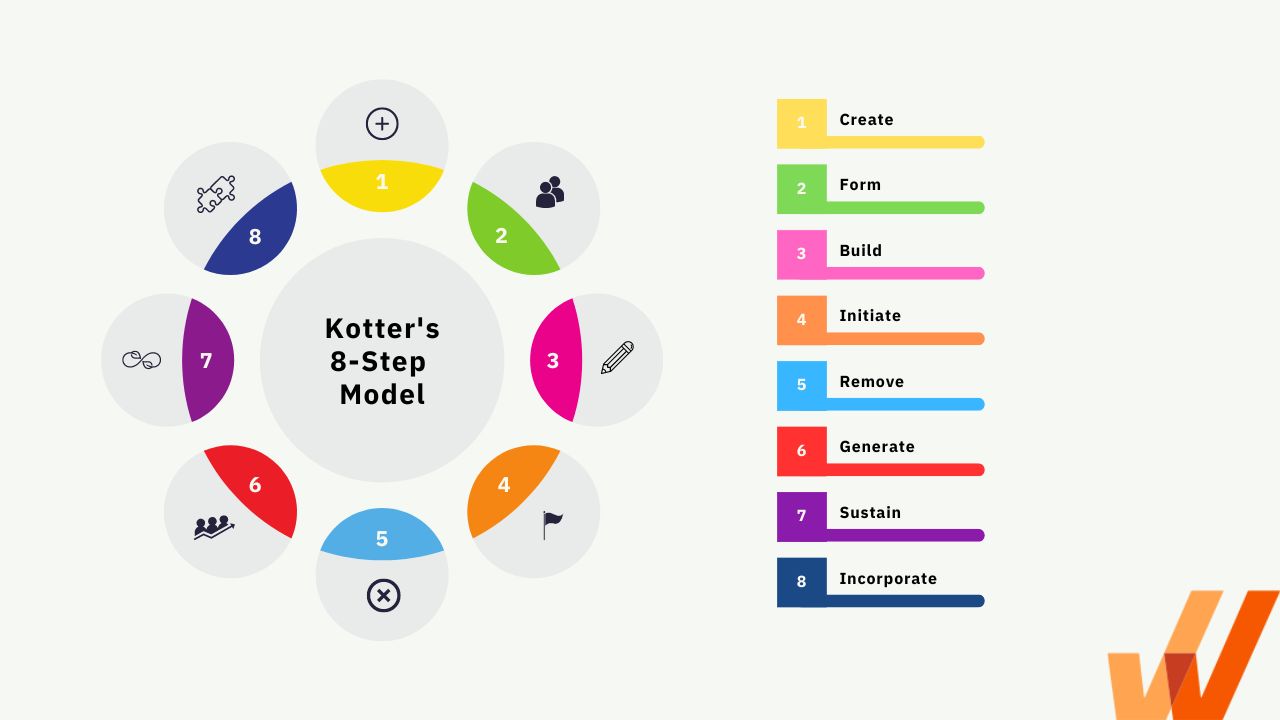Kotter’s 8-Step Change Model: Advantages & Disadvantages
- Published:
- Updated: July 24, 2024


Adapting to organizational change has always been challenging, with businesses experiencing a change failure rate of over 70%.
As change becomes more constant, organizations rely on change management models to support their initiatives from conception to implementation. One such proven change model is Kotter’s 8 Steps for Leading Change.
Kotter’s 8-step framework provides a path for organizations to overcome the barriers to change success based on research from Dr. John Kotter, an emeritus from Harvard Business School and later founder of Kotter International.
In this article, we breakdown each of the eight steps in Kotter’s model of change, explore Kotter’s change management principles that drive the best results, look at pros and cons of his change model, and more.
What Are the 8-Steps of Kotter's Change Model?
What Is Kotter’s 8-Step Change Model?
Kotter’s 8-Step Change Model is a popular change management model. It empowers organizations to accelerate organizational change through proper planning, mobilizing employees, removing friction, and instituting change into a company’s culture. This process enables companies to overcome the challenges faced by constant change, from implementing new technology, changes to organizational structure, new product lines, acquisitions and mergers, and more.
Dr. John Kotter first introduced the 8-step change model in his 1996 book Leading Change. His findings came from observing hundreds of leaders at enterprise companies who were tasked with transforming organizations and executing new strategies. From his observation, he identified and documented common success factors that led to successful change implementations.
With this knowledge, Dr. Kotter founded Kotter International, an organizational change foundation that helps companies drive large change projects based on his framework. He has since evolved his original eight steps to eight accelerators outlined in his followup books, Accelerate (2014) and CHANGE (2021).

The 8 Steps in Kotter’s Change Model
Kotter’s change framework includes eight steps (now called accelerators) used to drive change adoption and enabling organizations to successfully implement new strategies. Kotter’s eight steps include:
1. Create a sense of urgency
It’s human nature to maintain the status quo and have some form of resistance to change. However, a sense of urgency can often spark the initial motivation to initiate a change implementation process.
It’s critical to communicate the need, and reason, for upcoming change projects for employees to understand it as a solution to an existing problem or risk. As a change agent or change consultant, you must obtain the buy-in of at least 75% of the organization’s management to lead effective change.
Examples of how to create a sense of urgency include:
- Showcase how other companies have failed to act on similar issues and the negative impact it had on their company.
- Highlight how companies have implemented the change and the success it has brought.
- Demo the potential of the change in company all-hands.
2. Form a guiding coalition
Driving a change initiative isn’t a one-person job. The ‘Leadership + Management’ change principle stresses that organizational changes need multiple leaders’ opinions, ideas, and support.
Your guiding coalition comprises people you choose as your support system, including managers and supervisors under effective change leadership.
Another principle applicable here is ‘Select Few + Diverse Many’ principle. Designated change leaders (select few) delegate tasks to experienced individuals (Diverse Many). Educate them about the reason for the change to feel confident in its need, to ensure that you have support from various functions.
Organizations should form a guiding coalition by:
- Building a change advisory board that all large, transformational change projects are run through.
- Form cross-functional change teams for individual change projects that include team members that will be most impacted by the change and who best understand the current state issues and the contextual reasons for the change.
- Encourage individual contributors across your organization who have strong influence to act as change agents.
3. Build a strategic vision
A change initiative is often challenging to understand at the lower hierarchical levels. Start with a change management plan that clearly outlines all project milestones and deliverables. When the vision is only in your head, it’s easy to underestimate how long the initiatives, such as training or data migrations, will take. A documented vision helps you balance various aspects of the change implementation and set more realistic timelines.
Examples of how to create a vision of change includes:
- Creating a change roadmap with key project milestones.
- Showcasing how a change will setup organizations to evolve further once they’re in place.
- Tying individual change projects to business outcomes and success KPIs.
- Tying individual change projects to larger enterprise digital strategies.
4. Enlist a volunteer army of change agents
Organizations often focus more on a change’s logistics over properly communicating the change. Change must be understood and supported for it to be successful – without effective change management communication, the change initiative is likely to fail. As a change practitioner, you must:
- Talk often about your vision and change implementation plan
- Address employees’ concerns transparently
- Apply your vision to all operational aspects – from training to performance reviews
- Lead the change by setting an example
5. Remove barriers to change adoption
The top-to-bottom approach of change imposition is often met with employee pushback. To successfully drive the change, you must identify all the factors likely to reduce its chances for success.
Whether it’s individuals, org culture, or limited resources, there will likely be a few barriers to change. Identify these obstacles as early as possible and rely on available resources to break them down without disrupting other business areas.
Examples of change barriers organizations must overcome include:
- Lack of clarity on why a change is happening.
- Internal resistance to change.
- Lack of leadership and stakeholder buy-in.
- Lack of IT or change governance.
- Change fatigue.
- Poor understanding of new techniques or lacking skillsets.
6. Generate short-term wins
Implementing change is a long and cumbersome process. To keep your employees motivated throughout their change journey, you must recognize and celebrate short-term wins and achievements.
Organizations can generate and showcase short-term wins by:
- Setting achievable milestones with incentives for hitting each.
- Using employee recognition tools to reward team members who are early adopters.
- Create self-service data studios and goal boards that showcase your change goal’s progress.
- Announce organizational change wins and success stories in Slack, through email, in team meetings, and in ‘Lunch and Learn’ style presentations.
- Highlight how early adopters are overachieving in comparison to laggards.
7. Sustain change as a continuous process
There is a large gap between implementation and complete adoption. A change initiative can easily fail if the people driving the change become complacent due to short-term success or get disheartened due to barriers.
Organizational leaders can sustain change as a continuous process by:
- Creating an overall change management strategy for your entire organization that includes processes for submitting change idea charters, how to prioritize change initiatives, etc.
- Make “fail fast and continuously” a pillar of your culture to encourage employees not to fear failure and always seek improvements.
- Encouraging employees to build and present project charters for change projects and innovations.
- Gather feedback on change projects from individual employees, c-suite, and the change implementation team.
8. Institute change into your organization’s DNA
Change initiatives require behavioral change, and for a change to be fully adopted, it must be deeply rooted in an organization’s culture and processes. According to Accelerate, “accelerators 1-7 are all about building new muscles.” The final aspect of Kotter’s 8-step change model is about maintaining those new muscles.
Examples of how organizations can integrate change into their company’s culture include:
- Enable employees with continuous upskill training to improve their skill sets.
- Support employees with contextual performance support in the flow of work to build habits, lower time-to-proficiency, and improve productivity.
- Provide change management training and coaching to help employees become more adaptive and innovative, and less resistance of new things.
- Contibute case studies and PR stories to enterprise publications highlighting your company’s change-driven culture.
Corporate Example of Applying Kotter’s Model of Change
The cloud data services and management organization NetApp was on the verge of losing its business, facing tough new competition that. It applied Kotter’s 8-step change model to achieve three strategic goals:
- Grow its market share
- Implement global partnerships
- Drive organization efficiencies
Applying these goals led NetApp to bundle its solutions into packages, as well as create a new streamlined approach to sales. After the application of Kotter’s model, NetApp saw a 44% increase in revenue, a 55% increase in sales, and a $14 billion growth in market capitalization.
Advantages of Kotter's Change Model
Given that Kotter’s model dates back to the 90s, is it still relevant for organizations?
To answer this question, let’s look at the advantages of using Kotter’s change model:
- It’s easy to implement. Kotter’s 8-Step Change Model is an easy-to-implement, step-by-step change management model that provides a clear description of the entire change process.
- Focuses on buy-in from various stakeholders across the organization. Emphasis is on the involvement and acceptability of the employees by forming a guiding coalition and getting organizational buy-in for the change initiative’s success.
- It highlights the importance of creating a sense of urgency. Therefore, this mindset and a well-drafted change vision can set your organization up for success.
✓ Thank you, the checklist will be sent to your email
Disadvantages of Kotter's Change Model
Like any other change management model, Kotter’s model also has certain flaws, and while implementing this change model, you must balance out the following drawbacks:
- The process focuses highly on creating urgency but lacks detail.
- The model is sequential and time-consuming. Missing out on any steps can lead your change management team astray.
- Being a top-down model, it limits the scope of employee participation, resulting in frustration.
4 Principles of Kotter’s Change Management Model
While Kotter’s book- Leading Change encourages completing eight steps sequentially, Accelerate recommends running the steps concurrently and continuously.
Instead of treating them as separate steps, they should be worked on simultaneously and should include the four change principles:
- Leadership and Management: Managers must support the change the administration requires for the initiative to succeed.
- Head and Heart: Data and logic alone are unlikely to motivate people to adopt a new business process or software implementation, communicating how they will personally benefit from the alteration to make what’s new more appealing or, even better, desirable.
- Select Few and Diverse Many: You need a core group of supporters from different hierarchy levels and varied job experiences. Prepare to recruit support from multiple levels of management, including those closer to the employees whose day-to-day work is most affected by the transformation.
- “Have To” and “Want To”: Transitions run more smoothly — and faster — when those affected by it want it to happen.
Working concurrently through the steps can help you move through the change process faster, but it only works if you have a large amount of support from all levels.
The Leadership + Management and Select Few + Diverse Many principles help you build the foundation. The Head + Heart and “Have To” + “Want To” principles are designed to keep momentum throughout the organizational transformation.
Kotter’s 8-step-model is a people-centric, structured approach that helps organizations reduce change resistance – the most common barrier that delays the change management process. Plan and seek out the support of change management tools to easily embrace the change.
Contact Whatfix to discuss how our customized digital adoption platform can speed up employee onboarding, provide on-demand training, and support your team through significant organizational changes.

Above: In-app employee guidance created with the Whatfix Digital Adoption Platform
Whatfix’s DAP empowers organizations with a no-code editor to create in-app guided flows, onboarding tasklists, pop-ups, tooltips, alerts, reminders, self-help wikis, and more to enable employees to use software better. Enable your employees to become proficient in new applications faster, create interactive process documentation, guide users through process changes, assist employees through infrequent tasks, and provide self-help performance support on your CRM, ERP, HCM, or any desktop, web, or mobile application.
Request a demo to see how Whatfix empowers organizations to improve end-user adoption and provide on-demand customer support
Thank you for subscribing!


